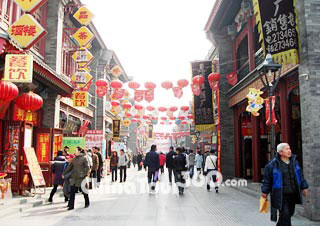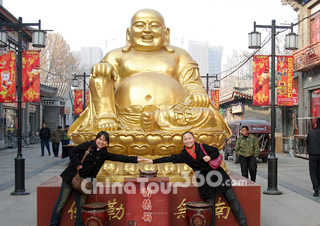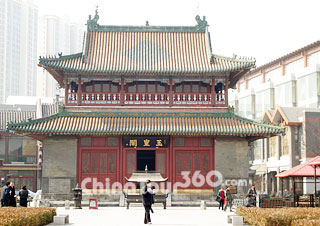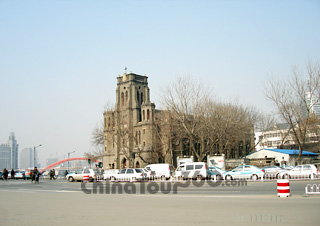![]() Facts
Facts
Phone Code: 022
Postal Code: 300000 – 301900
Area: 11,946.88 square kilometers (square miles)
Population: 13,548,800 (2011 statistics)
Neighboring Areas: Beijing, Chengde, Tangshan, Langfang, Cangzhou
Location: Tianjin, located at the northeast of Northern China Plain and at the center of circum Bohai Sea area. It faces the Bohai Sea to the east and leans against the Mt. Yanshan to the north. The city is about 120 km (74.6 miles) from Beijing. Its longitude lies between 116º43' - 118º04' E and the latitude is between 38º34' - 40°15' N.
Physical Features: Plains and lowlands cover most of the land, and the Haihe River flows through the city. The north is high with low mountains and hills and the highest point is 1,078.5 meters (3,538.4 feet) above sea level, while the southeast area is low and with an average height of 3.5 meters (11.5 feet) above sea level.
 |
| Tianjin Maps |
![]() History: Tianjin, or Jin for short, is the third largest city and one of the four municipalities in China. Its history dates back to the Sui Dynasty (581 - 618), when the Grand Canal was opened. The earliest Tianjin was formed where the South and the North Canal meet. Druing the late Tang Dynasty (618 - 907), it became a terminal for grains and silk was transported from the south to the north. The city was officially founded in 1404 during the Ming Dynasty (1368 - 1644) and has a history of over 600 years.
History: Tianjin, or Jin for short, is the third largest city and one of the four municipalities in China. Its history dates back to the Sui Dynasty (581 - 618), when the Grand Canal was opened. The earliest Tianjin was formed where the South and the North Canal meet. Druing the late Tang Dynasty (618 - 907), it became a terminal for grains and silk was transported from the south to the north. The city was officially founded in 1404 during the Ming Dynasty (1368 - 1644) and has a history of over 600 years.
![]() Attractions: There are not only historical relics but also beautiful natural scenery in the city. Tianjin Great Wall, including Huangyaguan Pass and Taipingzhi Great Wall, are located in the Ji County. The Dule Temple in Ji County has a history of over 1,000 years. First built in 636 during the Tang Dynasty and rebuilt in 984 during the Liao Dynasty (916 - 1125), Dule Temple is the oldest high pavilion building built into timber structure. Mt. Panshan is famous for its picturesque scenery. The Ancient Cultural Street was once the place where people worshiped the god of the sea and an entertainment place for seamen. Now it is a commercial street centered on Tianhou Palace. Dagukou Port was an ancient fort during the Ming and Qing (1644 - 1911) Dynasties. The Haihe Park lies at the bank of Haihe River, which boasts beautiful river and city views. It is also an ideal place for recreation.
Attractions: There are not only historical relics but also beautiful natural scenery in the city. Tianjin Great Wall, including Huangyaguan Pass and Taipingzhi Great Wall, are located in the Ji County. The Dule Temple in Ji County has a history of over 1,000 years. First built in 636 during the Tang Dynasty and rebuilt in 984 during the Liao Dynasty (916 - 1125), Dule Temple is the oldest high pavilion building built into timber structure. Mt. Panshan is famous for its picturesque scenery. The Ancient Cultural Street was once the place where people worshiped the god of the sea and an entertainment place for seamen. Now it is a commercial street centered on Tianhou Palace. Dagukou Port was an ancient fort during the Ming and Qing (1644 - 1911) Dynasties. The Haihe Park lies at the bank of Haihe River, which boasts beautiful river and city views. It is also an ideal place for recreation.
![]() Transportation
Transportation
![]() Air: Domestic and scheduled international flights are operated by the Tianjin Binhai International Airport which is about 13 km (8 miles) from the city center and 134 km (83 miles) from Beijing.
Air: Domestic and scheduled international flights are operated by the Tianjin Binhai International Airport which is about 13 km (8 miles) from the city center and 134 km (83 miles) from Beijing.
![]() Train: Normal and high-speed trains are operated by the four train stations: the Tianjin Railway Station (East Railway Station), South Railway Station, West Railway Station, and Tanggu Railway Station.
Train: Normal and high-speed trains are operated by the four train stations: the Tianjin Railway Station (East Railway Station), South Railway Station, West Railway Station, and Tanggu Railway Station.
- Beijing - Tianjin
- Tianjin - Beijing
- Shanghai - Tianjin
- Tianjin - Shanghai
- Harbin - Tianjin
- Tianjin - Xian
- Tianjin - Jinan
- Xian - Tianjin
- Shenyang - Tianjin
- Qingdao - Tianjin
- Tianjin - Zibo
- Nanjing - Tianjin
- Jinan - Tianjin
- Tianjin - Zhengzhou
- Tianjin - Shijiazhuang
- Tianjin - Nanjing
- Tianjin - Datong
- Tianjin - Hangzhou
- Ningbo - Tianjin
- Tianjin - Harbin
![]() Bus: More than 300 long-distance bus routes radiate to other cities and towns in China. There are 8 long-distance bus stations in the city: the West, Dahutong, Hongqiao, Caiyuan, Jinyu, Baodi, Lutai, and Jinghai Long-distance Bus Stations.
Bus: More than 300 long-distance bus routes radiate to other cities and towns in China. There are 8 long-distance bus stations in the city: the West, Dahutong, Hongqiao, Caiyuan, Jinyu, Baodi, Lutai, and Jinghai Long-distance Bus Stations.
![]() Subway: Tianjin Subway Line 1 (from Liu Yuan to Shuang Lin) and Line 9 (from Tianjin Railway Station to Donghai Road) are already in operation. Line 2, traveling to Binhai International Airport, and Line 3, from Huayuan Industry Zone to Xiaodian Station, are completed and ready to be opened soon. Lines 4, 5, and 6 are still under construction.
Subway: Tianjin Subway Line 1 (from Liu Yuan to Shuang Lin) and Line 9 (from Tianjin Railway Station to Donghai Road) are already in operation. Line 2, traveling to Binhai International Airport, and Line 3, from Huayuan Industry Zone to Xiaodian Station, are completed and ready to be opened soon. Lines 4, 5, and 6 are still under construction.
![]() Inter-city Bus: There are over 300 bus routes linking most areas in the city, including sight-seeing routes and airport shuttle bus routes.
Inter-city Bus: There are over 300 bus routes linking most areas in the city, including sight-seeing routes and airport shuttle bus routes.
![]() Ferry: There are regular ferries from Tianjin Port to Lianyungang, Japan and Korea. The newly opened Tianjin International Cruise Home Port also operates international cruise ships to/from Korea, Japan, Thailand, and Singapore.
Ferry: There are regular ferries from Tianjin Port to Lianyungang, Japan and Korea. The newly opened Tianjin International Cruise Home Port also operates international cruise ships to/from Korea, Japan, Thailand, and Singapore.
![]() Taxi: The basic taxi fare is CNY 8 for the first 3 km (1.86 miles), and additional CNY 1.70 per kilometer is charged beyond that. A fuel surcharge of CNY 1 is also chargeable.
Taxi: The basic taxi fare is CNY 8 for the first 3 km (1.86 miles), and additional CNY 1.70 per kilometer is charged beyond that. A fuel surcharge of CNY 1 is also chargeable.
![]() Weather: The city has a temperate monsoon climate, influenced greatly by the monsoon. Spring is windy and dry, summer is hot, autumn is cool, and winter is dry. Hence, the best time to visit the city is either late spring, early summer or during the autumn season.
Weather: The city has a temperate monsoon climate, influenced greatly by the monsoon. Spring is windy and dry, summer is hot, autumn is cool, and winter is dry. Hence, the best time to visit the city is either late spring, early summer or during the autumn season.
![]() Dining and Shopping
Dining and Shopping
Tianjin Goubuli Stuffed Buns, 18th Street Fried Dough Twist, and Erduoyan Fried Cake are the three most famous local snacks. Caoji Donkey, Guanshenyuan Lamb Leg, and Baiji Dumplings are also popular food. Many local snacks can be found in Nanshi Food Street.
Heping Road - Binjiang Road are the famous commercial area, where shops and stores selling various goods are found. The three largest shopping centers, Quan Ye Chang, Hualian Mall, and Tianjin Department Store are located in this area. In addition, local handicrafts can be found in the Ancient Cultural Street and Nanshi Food Street.











